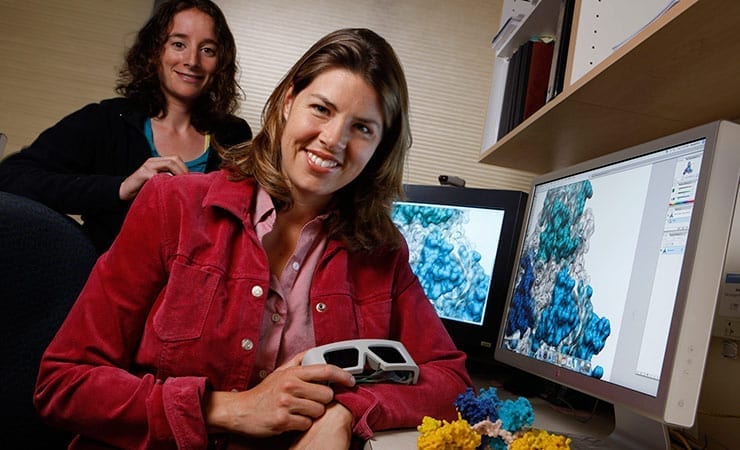Laboratories at The Scripps Research Institute (TSRI) are investigating antibodies to fight Ebola virus, including the three antibodies recently used to treat two American health care workers infected with the Ebola virus.
The condition of the American patients has reportedly improved since they received a highly experimental antibody cocktail called ZMapp, supplied by San Diego-based Mapp Biopharmaceutical.
The TSRI laboratories of Professor Erica Ollmann Saphire and Assistant Professor Andrew Ward are studying the structures of these antibodies using techniques called electron microscopy, which creates high-resolution images by hitting samples with electrons, and X-ray crystallography, which determines the atomic structure of crystalline arrays of proteins. Through these images, the team will discover exactly how the immune system molecules bind to the Ebola virus and stop it from functioning, a critical step in drug development.
Ebola virus causes an extremely virulent disease that currently leads to death in up to 90 percent of cases. The fast-moving virus is spread via the blood or other bodily fluids of an infected person,
“What we’re showing are sites of vulnerability on the surface of the virus,” said C. Daniel Murin, a graduate student in the Saphire and Ward labs. “These are the chinks in the armor of the virus and the places where you would want your anti-serum to target.”
The ZMapp treatment is still in experimental stages and has not yet been approved for use outside the two recent cases. According to Saphire, ZMapp is one of the best antibody cocktails currently known, but there may still be ways to improve it. She is currently leading a $28 million National Institutes of Health-funded consortium to test antibody cocktails from laboratories around the world, with the goal of finding the best for neutralizing Ebola virus and the many other viruses like it.
An ideal antibody cocktail would ease symptoms and improve the prognosis of infected individuals—it could even work as a preventative measure, protecting health care workers before they enter an infected area.
The work on the Ebola virus is part of a larger Vaccine and Global Health Initiative at TSRI (.pdf), which includes research on HIV/AIDS, influenza and tuberculosis.
Source: The Scripps Research Institute, adapted. Image: Scripps Research Institute Professor Erica Ollmann Saphire (right) heads a consortium to find the best antibody cocktail to treat deadly Ebola virus infections; Dafna Abelson (left), a research assistant in the Saphire lab at TSRI. Credit: TSRI
Editor’s Note: Please find below links to select publications by Dr. Erica Ollmann Saphire and colleagues:
- Crystal structure of Marburg virus VP24
- Ebolavirus VP35 coats the backbone of double-stranded RNA for interferon antagonism
- Lassa fever in post-conflict Sierra Leone
- Ebolavirus VP35 uses a bimodal strategy to bind dsRNA for innate immune suppression
- Neutralizing Ebolavirus: structural insights into the envelope glycoprotein and antibodies targeted against it
- Structural rearrangement of Ebola virus VP40 begets multiple functions in the virus life cycle



